holy sonnet 10
- 格式:doc
- 大小:51.50 KB
- 文档页数:5
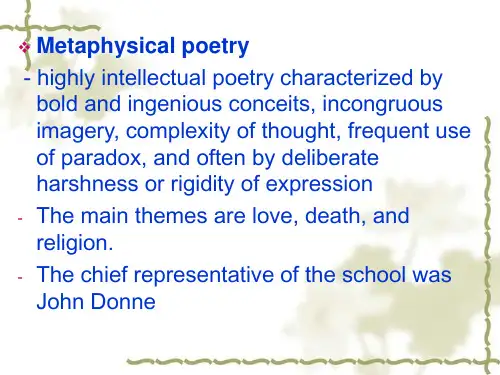
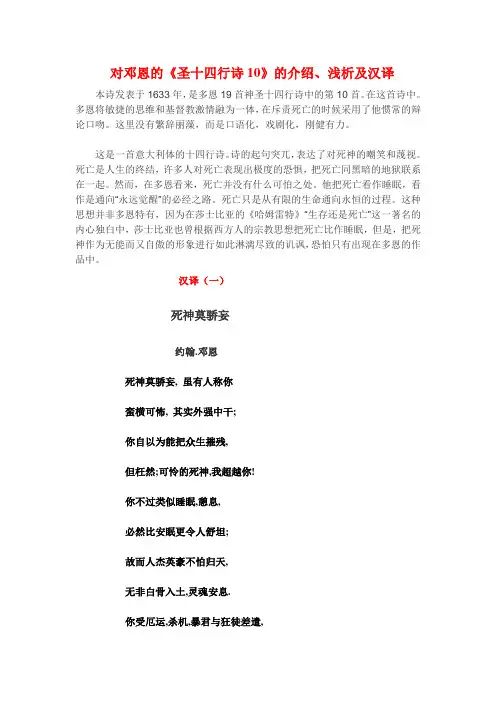
对邓恩的《圣十四行诗10》的介绍、浅析及汉译本诗发表于1633年,是多恩19首神圣十四行诗中的第10首。
在这首诗中。
多恩将敏捷的思维和基督教激情融为一体,在斥责死亡的时候采用了他惯常的辩论口吻。
这里没有繁辞丽藻,而是口语化,戏剧化,刚健有力。
这是一首意大利体的十四行诗。
诗的起句突兀,表达了对死神的嘲笑和蔑视。
死亡是人生的终结,许多人对死亡表现出极度的恐惧,把死亡同黑暗的地狱联系在一起。
然而,在多恩看来,死亡并没有什么可怕之处。
他把死亡看作睡眠,看作是通向“永远觉醒”的必经之路。
死亡只是从有限的生命通向永恒的过程。
这种思想并非多恩特有,因为在莎士比亚的《哈姆雷特》“生存还是死亡”这一著名的内心独白中,莎士比亚也曾根据西方人的宗教思想把死亡比作睡眠,但是,把死神作为无能而又自傲的形象进行如此淋漓尽致的讥讽,恐怕只有出现在多恩的作品中。
汉译(一)死神莫骄妄约翰.邓恩死神莫骄妄, 虽有人称你蛮横可怖, 其实外强中干;你自以为能把众生摧残,但枉然;可怜的死神,我超越你!你不过类似睡眠,憩息,必然比安眠更令人舒坦;故而人杰英豪不怕归天,无非白骨入土,灵魂安息.你受厄运,杀机,暴君与狂徒差遣,用毒药,战争和疾病害人;鸦片与妖术也能使人昏,且更灵验,你何必如此气焰!凡人了却浮生,但精神永生,超脱死的魔掌,灭绝死神!从诗的结构来看,第一、二行“死亡,不要骄傲,虽然有人说你/强大而又可怖,而你并不真的这样”,是论点,而第二行到第八行是论据,说明死亡没有什么可怕,死亡同睡眠没有多少不同,都可以使人“获得身体的休息,灵魂的解脱”。
第九、十行指出死神的无能,而第十一、二行说明死神并没有什么独特之处,没有什么可资骄傲的理由。
这四行进一步提供论据,来支持诗人的论点。
第十三、四行则是结论。
虽然这首诗有很强的论说性,但表达了诗人对死神的蔑视和无畏之情。
情与理的结合使诗本身具有有说服力,而比喻的运用使这篇说理的诗生动。
整个诗作铿锵有力,富于阳刚之气。
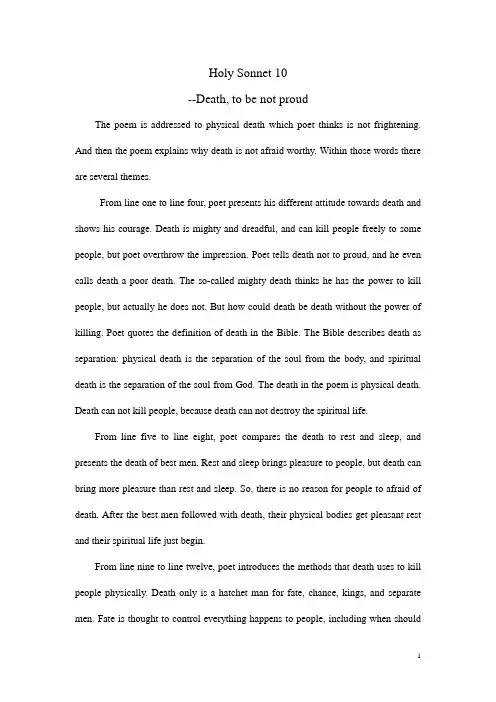
Holy Sonnet 10--Death, to be not proudThe poem is addressed to physical death which poet thinks is not frightening. And then the poem explains why death is not afraid worthy. Within those words there are several themes.From line one to line four, poet presents his different attitude towards death and shows his courage. Death is mighty and dreadful, and can kill people freely to some people, but poet overthrow the impression. Poet tells death not to proud, and he even calls death a poor death. The so-called mighty death thinks he has the power to kill people, but actually he does not. But how could death be death without the power of killing. Poet quotes the definition of death in the Bible. The Bible describes death as separation: physical death is the separation of the soul from the body, and spiritual death is the separation of the soul from God. The death in the poem is physical death. Death can not kill people, because death can not destroy the spiritual life.From line five to line eight, poet compares the death to rest and sleep, and presents the death of best men. Rest and sleep brings pleasure to people, but death can bring more pleasure than rest and sleep. So, there is no reason for people to afraid of death. After the best men followed with death, their physical bodies get pleasant rest and their spiritual life just begin.From line nine to line twelve, poet introduces the methods that death uses to kill people physically. Death only is a hatchet man for fate, chance, kings, and separate men. Fate is thought to control everything happens to people, including when shouldone dies. Chance is the opposite of fate. Chance is luck, the possibility of things that will happen to someone. Kings are from different perspective. Kings are real power in human world, but they can also have the power to decide one’s life. Desperate men have no power to control their fates; they have no chance or power. However, desperate men can make a suicide choice. They have the rights to control their own life. Poison, war, sickness dwell, poppy and charms are the methods death uses to kill people.In the line five and six, poet compares death to rest and sleep. In the line thirteen, “the short sleep past” means the physical death past; “we wake eternally” means our spiritual life just begins. During this piece of work, John Donne had suffered a major illness during his eighth year as an Anglican minister that had brought him close to the grasp of death. The last line was an announcement to show poet’s determination and courage.There are three themes within the fourteen lines: courage, death and wish.Courage is the obvious theme in the sonnet. Throughout the entire poem, poet never drops his guard. Call death a poor death; compare death with rest and sleep; list the methods death uses to kill physical life are the expressions of courage against death. Poet belittles the power of death to show others that he is brave, and he has the courage to fight against it.Death always can be a topic for poem. Western people treat death in a religion way. Death has its religion meanings in west. In Christian world, death has two aspects: physical death and spiritual death. In poet’s mind the physical death can onlytake body away, and the spiritual life will get eternity. According to poet, death is working for fate, chance, kings and desperate men, and it has many ways to kill people physically. But when someone gets strong enough, no one can bring death to him or her.The last line of the poem shows the poet’s determination of living. He believes death is dead in spiritual world. The sickness may take poet’s physical life away, but his spirit will never lose. The wish in the poem is to defeat death and find the eternal spirit. Eternal spirit is about faith. The faith contains courage and wisdom.This poem is an announcement from poet to show that he has the determination to fight against death by expressing his own attitude which exposes a truth that death has no need to be afraid.。
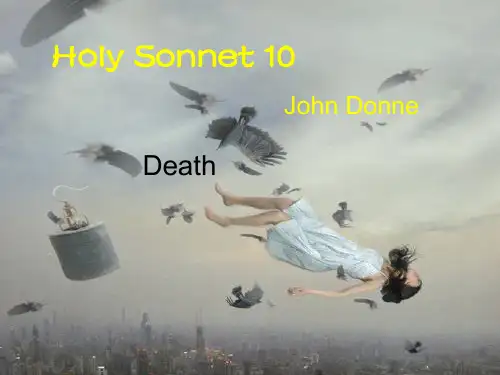
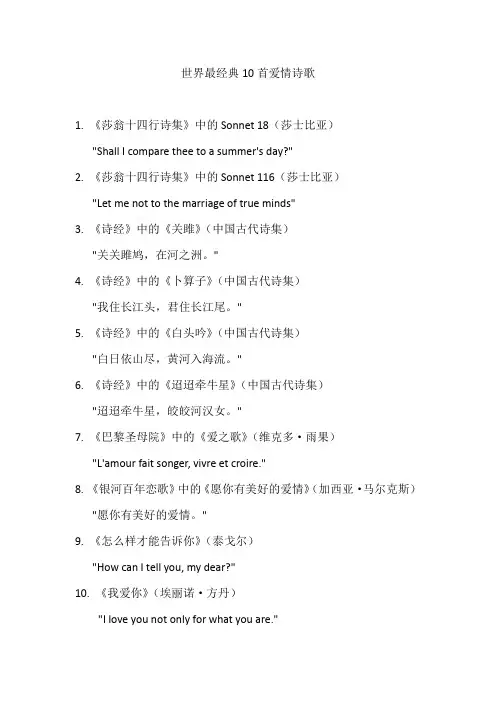
世界最经典10首爱情诗歌
1. 《莎翁十四行诗集》中的Sonnet 18(莎士比亚)
"Shall I compare thee to a summer's day?"
2. 《莎翁十四行诗集》中的Sonnet 116(莎士比亚)
"Let me not to the marriage of true minds"
3. 《诗经》中的《关雎》(中国古代诗集)
"关关雎鸠,在河之洲。
"
4. 《诗经》中的《卜算子》(中国古代诗集)
"我住长江头,君住长江尾。
"
5. 《诗经》中的《白头吟》(中国古代诗集)
"白日依山尽,黄河入海流。
"
6. 《诗经》中的《迢迢牵牛星》(中国古代诗集)
"迢迢牵牛星,皎皎河汉女。
"
7. 《巴黎圣母院》中的《爱之歌》(维克多·雨果)
"L'amour fait songer, vivre et croire."
8. 《银河百年恋歌》中的《愿你有美好的爱情》(加西亚·马尔克斯)
"愿你有美好的爱情。
"
9. 《怎么样才能告诉你》(泰戈尔)
"How can I tell you, my dear?"
10. 《我爱你》(埃丽诺·方丹)
"I love you not only for what you are."。
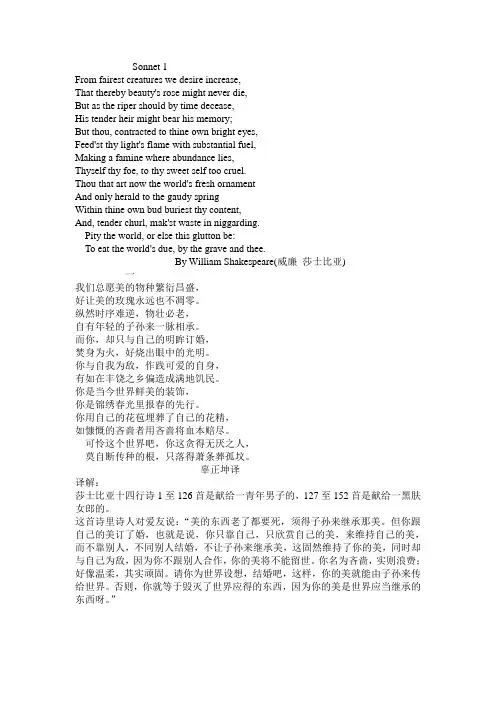
From fairest creatures we desire increase,That thereby beauty's rose might never die,But as the riper should by time decease,His tender heir might bear his memory;But thou, contracted to thine own bright eyes,Feed'st thy light's flame with substantial fuel,Making a famine where abundance lies,Thyself thy foe, to thy sweet self too cruel.Thou that art now the world's fresh ornamentAnd only herald to the gaudy springWithin thine own bud buriest thy content,And, tender churl, mak'st waste in niggarding.Pity the world, or else this glutton be:To eat the world's due, by the grave and thee.By William Shakespeare(威廉莎士比亚)一我们总愿美的物种繁衍昌盛,好让美的玫瑰永远也不凋零。
纵然时序难逆,物壮必老,自有年轻的子孙来一脉相承。
而你,却只与自己的明眸订婚,焚身为火,好烧出眼中的光明。
你与自我为敌,作践可爱的自身,有如在丰饶之乡偏造成满地饥民。
你是当今世界鲜美的装饰,你是锦绣春光里报春的先行。
你用自己的花苞埋葬了自己的花精,如慷慨的吝啬者用吝啬将血本赔尽。
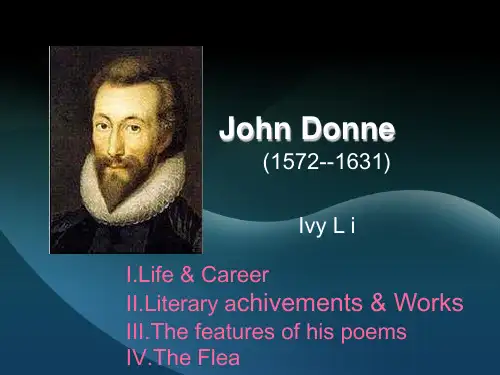
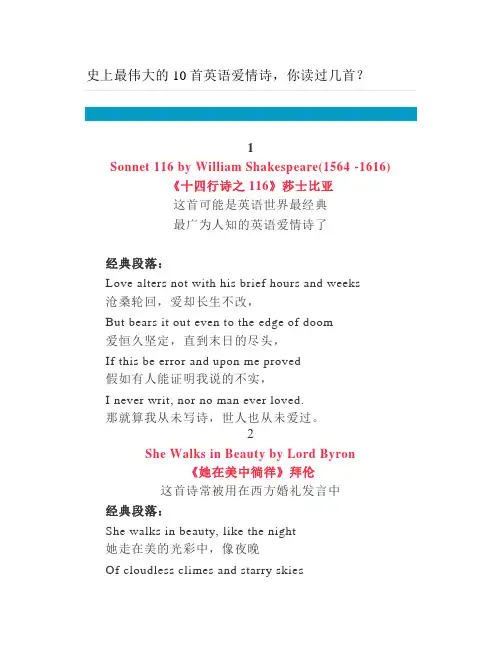
史上最伟大的10首英语爱情诗,你读过几首?1Sonnet 116 by William Shakespeare(1564 -1616)《十四行诗之116》莎士比亚这首可能是英语世界最经典最广为人知的英语爱情诗了经典段落:Love alters not with his brief hours and weeks沧桑轮回,爱却长生不改,But bears it out even to the edge of doom爱恒久坚定,直到末日的尽头,If this be error and upon me proved假如有人能证明我说的不实,I never writ, nor no man ever loved.那就算我从未写诗,世人也从未爱过。
2She Walks in Beauty by Lord Byron《她在美中徜徉》拜伦这首诗常被用在西方婚礼发言中经典段落:She walks in beauty, like the night她走在美的光彩中,像夜晚Of cloudless climes and starry skies皎洁无云而且繁星漫天;And all that's best of dark and bright黑夜与白天最美妙的色彩;Meet in her aspect and her eyes都在她的面容和目光里显现。
3I loved you first: but afterwards your love... byChristina Rossetti《虽然我先爱你》罗塞蒂经典段落:I loved you first, but afterwards your love outsoaring mine虽然我先爱你,但后来你的爱却超越了我,For one is both and both are one in love因为真爱不分你我,Rich love knows nought of ‘thine that is not mine 丰盛的爱不分彼此;Both have the strength and both the length thereof 所以我们才有力量走向永恒,Both of us, of the love which makes us one你和我,因为爱,成为一体。
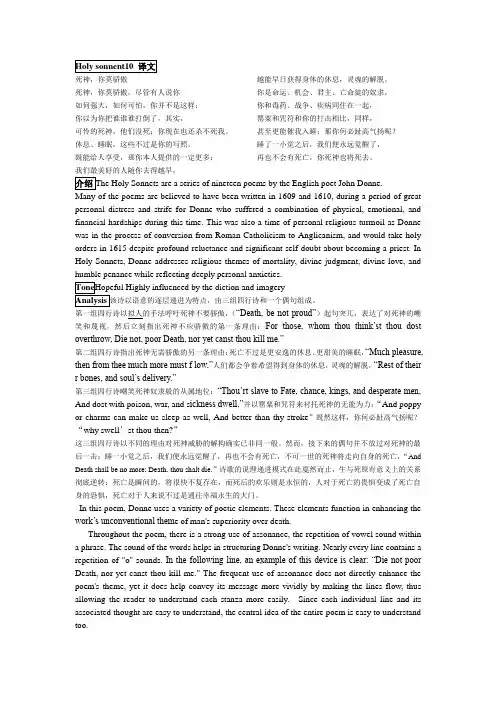
死神,你莫骄傲死神,你莫骄傲,尽管有人说你如何强大,如何可怕,你并不是这样;你以为你把谁谁谁打倒了,其实,可怜的死神,他们没死;你现在也还杀不死我。
休息、睡眠,这些不过是你的写照,既能给人享受,那你本人提供的一定更多;我们最美好的人随你去得越早,越能早日获得身体的休息,灵魂的解脱。
你是命运、机会、君主、亡命徒的奴隶,你和毒药、战争、疾病同住在一起,罂粟和咒符和你的打击相比,同样,甚至更能催我入睡;那你何必趾高气扬呢?睡了一小觉之后,我们便永远觉醒了,再也不会有死亡,你死神也将死去。
Many of the poems are believed to have been written in 1609 and 1610, during a period of great personal distress and strife for Donne who suffered a combination of physical, emotional, and financial hardships during this time. This was also a time of personal religious turmoil as Donne was in the process of conversion from Roman Catholicism to Anglicanism, and would take holy orders in 1615 despite profound reluctance and significant self-doubt about becoming a priest. In Holy Sonnets, Donne addresses religious themes of mortality, divine judgment, divine love, and humble penance while reflecting deeply personal anxieties.第一组四行诗以拟人的手法呼吁死神不要骄傲,(“Death, be not proud”)起句突兀,表达了对死神的嘲笑和蔑视,然后立刻指出死神不应骄傲的第一条理由:For those, whom thou think’st thou dost overthrow, Die not, poor Death, nor yet canst thou kill me.”第二组四行诗指出死神无需骄傲的另一条理由:死亡不过是更安逸的休息、更甜美的睡眠,“Much pleasure, then from thee much more must f low,”人们都会争着希望得到身体的休息,灵魂的解脱,“Rest of their r bones, and soul’s delivery.”第三组四行诗嘲笑死神奴隶般的从属地位:“Thou’rt slave to Fate, chance, kings, and desperate men, And dost with poison, war, and s ickness dwell,”并以罂粟和咒符来衬托死神的无能为力:“And poppy or charms can make us sleep as well, And better than thy stroke”既然这样,你何必趾高气扬呢?“why swell’st thou then?”这三组四行诗以不同的理由对死神威胁的解构确实已非同一般。
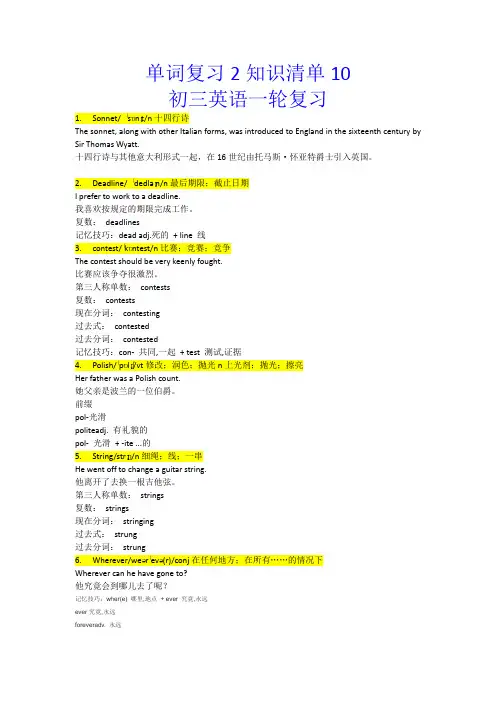
单词复习2知识清单10初三英语一轮复习1.Sonnet/ ˈsɒnɪt/n十四行诗The sonnet, along with other Italian forms, was introduced to England in the sixteenth century by Sir Thomas Wyatt.十四行诗与其他意大利形式一起,在16世纪由托马斯·怀亚特爵士引入英国。
2.Deadline/ ˈdedlaɪn/n最后期限;截止日期I prefer to work to a deadline.我喜欢按规定的期限完成工作。
复数:deadlines记忆技巧:dead adj.死的+ line 线3.contest/ˈkɒntest/n比赛;竞赛;竞争The contest should be very keenly fought.比赛应该争夺很激烈。
第三人称单数:contests复数:contests现在分词:contesting过去式:contested过去分词:contested记忆技巧:con-共同,一起+ test 测试,证据4.Polish/ˈpɒlɪʃ/vt修改;润色;抛光n上光剂;抛光;擦亮Her father was a Polish count.她父亲是波兰的一位伯爵。
前缀pol-光滑politeadj. 有礼貌的pol-光滑+ -ite ...的5.String/strɪŋ/n细绳;线;一串He went off to change a guitar string.他离开了去换一根吉他弦。
第三人称单数:strings复数:strings现在分词:stringing过去式:strung过去分词:strung6.Wherever/weərˈevə(r)/conj在任何地方;在所有……的情况下Wherever can he have gone to?他究竟会到哪儿去了呢?记忆技巧:wher(e) 哪里,地点+ ever 究竟,永远ever究竟,永远foreveradv. 永远for prep.支持+ ever 究竟,永远whateveradv. 无论什么what 什么+ ever 究竟,永远wheneverconj. 无论何时when interrogativeadv.何时+ ever 究竟,永远7.Barren/ˈbærən/adj贫瘠的;不结果实的The land was barren and infertile.这片土地荒芜而贫瘠。

1.P1 问答Three conquests(时间+意义):1)The Roman conquest, 55 BC, civilized, Christianized2)The English conquest, 5th century, old English, starting point of English literature3)The Norman conquest, 1066, Mid-English, establishment of feudalism.2.P3选择,填空,判断Beowulf, the national epic of English people.3.P4 诗歌翻译“Thus made their mourning the men of Geatland, 坟墓周围,勇士们骑着战马,For their hero’s passing, his hearth-companions 为逝去的国王唱起挽歌,Quoth that of all the kings of earth, 高赞你的懿德,分享你的恩泽,哀叹你的陨落,Of men he was the mildest and most beloved, 人们称你为最可亲最可敬的国王,To his kin the kindest,keenest to praise.” 你对人们总是最仁爱最热心,你最渴望的就是人们对你的赞扬。
4.P5 名词解释,问答Features of Beowulf:1)The use of alliteration. (头韵)(定义:in alliterative verse, certain accented words in a line begin with the same consonant sound.)2)The use of metaphors and of understatements(隐喻)(Grendel represents forest, she-monster represents water, fire-dragon represents sky)5.P8 选择填空判断英国Romance代表作: adventures of King Arthur and his Knights of the Round Table (《亚瑟王和他的圆桌骑士》,同时也是骑士文学代表作)6.P9 问答The class nature of the romance:1)The theme of loyalty to king and lord was repeatedly emphasized in romances, asloyalty was the corner-stone of feudal morality, without which the wholestructure of feudalism would collapse.2)They were composed for the noble, of the noble, and in most cases by the poetspatronized by the noble.7.P17 选择填空名词解释The Ballads(民谣): the most important department of English folk literature.1)定义:①A ballad is a story told in song, usually in four-line stanzas, with the secondand forth lines rhymed. ②They are mainly the literature of peasants, and in them one is able to understand the outlook of the English common people in feudal society.2)代表作:The Robin Hood Ballads (罗宾汉民谣)8.P19 选择填空判断1)Geoffrey Chaucer, the founder of English poetry, was born about 1340 in London.2)The Canterbury Tales(坎特伯雷故事集) is Chaucer’s masterpiece and one of themonumental works in English literature.9.P25 问答Chaucer’s language and contribution:1)Chaucer’s language, now called Middle English, is vivid and exact. He is masterof word-pictures.2)He introduced from France the rhymed stanza of various types, especially therhymed couplet of 5 accents in iambic meter (the heroic couplet) to English poetry, instead of the old Anglo-Saxon alliterative verse.3)Chaucer did much in making the dialect of London standard for the modernEnglish speech.10.P27 问答Preparation for the English Renaissance:1)The establishment of the new monarchy2)Religious Reformation: the appearance of Protestantism3)Language and cultural preparation: the publish of English Bible11.P28 名词解释选择判断King James Bible: the authorized version of English Bible, which was made in 1611 under the auspices of James.12.P30-31名词解释问答(文艺复兴:全答;人文主义:第三点)1)Renaissance 定义:The rise of the bourgeoisie soon showed its influence in thesphere of cultural life. The result is an intellectual movement known as the Renaissance, or, the rebirth of letters. It sprang first in Italy in the 14th century and gradually spread all over Europe.2)Features of Renaissance:①The one is the thirsting curiosity for the classical literature.②The Renaissance is the keen interests in the activities of humanity.3)Humanism 定义:Humanism is the keynote of the Renaissance. It reflected the newoutlook of the rising bourgeois class, which saw the world opening before it.According to the humanists, both men and the world are hindered only by external checks from infinite improvement. Man could mould the world according to his desires, and attain happiness by removing all external checks by the exercise of reason.13.P40-42 选择判断填空1)Edmund Spenser代表作:The Faerie Queene《仙后》2)The Spenserian Stanza(斯宾塞体)定义:The Faerie Queene is written in a special verseform that consists of eight iambic pentameter lines followed by a ninth line of sixiambic feet, with the rhyme scheme ababbcbcc. This form has since been called the Spenserian Stanza.14.P43 诗歌翻译A gentle Knight was pricking(=spurring) on the plaine, 一位高贵的骑士正策马穿过平原,Y-cladd(=clad) in mightie armes and silver shielde, 他全副武装,手持银盾,Wherein old dints of deepe wounds did remain, 盾上仍留着陈旧的深深的凹痕,The cruell markes of many a bloody fielde; 这残酷的标记来自多次血腥的战阵;Yet armes till that time did he never wield: 但这些武器至今他还未用过;His angry steede did chide his foming(=foaming) bitt, 他那愤怒的坐骑暴躁地咬着马勒,As much disdayning to the curbe to yield: 似乎桀骜不驯,不愿受主人的控制;Full jolly Knight he seemed , and faire did sitt, 他看上去是位真正的骑士,端坐马上,As one for knightly giusts and fierce en counters fitt. 好像准备参加骑士比武,迎接激烈对抗。
U1 Geoffrey Chaucer(1343-1400)生于富商之家,与王室关系密切,年轻时随军出征,在法国被俘《公爵夫人之书》(The Book of the Duchess)、《百鸟议会》(The Parliament of Fowls)、《声誉之堂》(The House of Fame)、《特洛勒斯和克丽西德》(Troilus and Criseyde)、《坎特伯雷故事》The Canterbury T ales.U2 William Shakespeare(1564-1616)《罗密欧和朱丽叶》(Romeo and Juliet 1595)、《威尼斯商人》(The Merchant of V enice 1596)、《亨利四世》(上篇)(Henry IV,Part I 1597)、《第十二夜》(Twelfth Night 1600)、《哈姆雷特》(Hamlet 1601)、《奥赛罗》(Othello 1604)、《李尔王》(King Lear 1605)、《麦克白》(Macbeth 1606)、《冬天的故事》(Winter’s Tale 1610)、《暴风雨》(The Tempest 1612)U3 Francis Bacon(1561-1626)《学术的推进》(Advancement of Learning 1605)《新工具》(New Instrument 1620)《新大西岛》(New Atlantics1626)、《论文集》(Essays1579)《论婚姻与单身》(of Marriage and Single Life)《论读书》(of Studies)U4 17th-Century British Poets John Donne (1572-1631) Songs and Sonnets中的《早安》(The Good-Morrow)、《破晓》(Break of Day)、《挽歌集》中的第16首(“On His Mistress”)、19首(“To His Mistress Going To Bed”),《圣十四行诗》(“Holy Sonnets”)中的第7首(“At the Round Earth’s Imagined Corner, Below”)和第10首(“Death Be Not Proud”)玄学派诗人的重要代表Metaphysical Poets The Flee跳蚤Holy Sonnet10John Milton(1608-1674)《利西达斯》(Lycidas, 1637)、《论出版自由》(“Areopagitica”,1644)、《失乐园》(Paradise Lost,1667)、《复乐园》(Paradise Regained,1671)、《力士参孙》。
Hamlet生存或毁灭, 这是个必答之问题:是否应默默的忍受坎苛命运之无情打击,还是应与深如大海之无涯苦难奋然为敌,并将其克服。
此二抉择, 就竟是哪个较崇高?死即睡眠, 它不过如此!倘若一眠能了结心灵之苦楚与肉体之百患,那么, 此结局是可盼的!死去, 睡去...但在睡眠中可能有梦, 啊, 这就是个阻碍:当我们摆脱了此垂死之皮囊,在死之长眠中会有何梦来临?它令我们踌躇,使我们心甘情愿的承受长年之灾,否则谁肯容忍人间之百般折磨,如暴君之政、骄者之傲、失恋之痛、法章之慢、贪官之侮、或庸民之辱,假如他能简单的一刃了之?还有谁会肯去做牛做马, 终生疲於操劳,默默的忍受其苦其难, 而不远走高飞, 飘於渺茫之境,倘若他不是因恐惧身後之事而使他犹豫不前?此境乃无人知晓之邦, 自古无返者。
所以,「理智」能使我们成为懦夫,而「顾虑」能使我们本来辉煌之心志变得黯然无光, 像个病夫。
再之, 这些更能坏大事, 乱大谋, 使它们失去魄力。
Romeo and Juliet罗密欧没有受过伤的才会讥笑别人身上的创痕。
(朱丽叶自上方窗户中出现)轻声!那边窗子里亮起来的是什么光?那就是东方,朱丽叶就是太阳!起来吧,美丽的太阳!赶走那妒忌的月亮,她因为她的女弟子比她美得多,已经气得面色惨白了。
既然她这样妒忌着你,你不要忠于她吧;脱下她给你的这一身惨绿色的贞女的道服,它是只配给愚人穿的。
那是我的意中人;啊!那是我的爱;唉,但愿她知道我在爱着她!她欲言又止,可是她的眼睛已经道出了她的心事。
待我去回答她吧;不,我不要太卤莽,她不是对我说话。
天上两颗最灿烂的星,因为有事他去,请求她的眼睛替代它们在空中闪耀。
要是她的眼睛变成了天上的星,天上的星变成了她的眼睛,那便怎样呢?她脸上的光辉会掩盖了星星的明亮,正像灯光在朝阳下黯然失色一样;在天上的她的眼睛,会在太空中大放光明,使鸟儿误认为黑夜已经过去而唱出它们的歌声。
瞧!她用纤手托住了脸,那姿态是多么美妙!啊,但愿我是那一只手上的手套,好让我亲一亲她脸上的香泽!朱丽叶唉!罗密欧她说话了。
Cinquain1----Youth hoodHave Only onceAnd will never returnBut everything is your optionCherish2-----TimeHappy, preciousOpening, waiting, travelingAll in good timePerfectQuatrain (AABB)3-----Time unbindOur twisted mindWe forget aversionOnly remember our wonderful occasion4-------- (ABAB)Charming princeKilled the monster on the land siteThis monster torment princess with malicious and ruthless ever since now, they are unite.5--------coupletTime is what we measure in minutes, hours, days, and years.Time is what we measure in cents, dimes, quarters, and dollars.6-----------haikuAs the sun shines throughI open my drowsy eyesA wonderful day7---------TankaCheerful graduatesSuccessfully pass the testdancing the partyWith wisdom and desiresWalk into the company.8---------TankaBeautiful campusWith red buildings and green doorsSolemn and divinebooming and new cedar treesStand tall and upright at ground9---------limerickSpring, girls like go out with teamSummer, children love ice creamAutumn, boys prefer touching the finishing lineWinter, the aged enjoy the sunshineSeasons, people were changing with stream10-------sonnetChildhood is pictured on innocenceOnly wish had the wigs of planeAdolescence just as the ship gets ready to set sail for FranceDesire for not be insaneHowever, adulthood resemble the shooting starLighted the skyChildren are already fulfilled to drive a carTeenagers are no longer shyThey are good natureThey are the image of the sun in the morningVigorous, young blood, responsible, and matureAmbition was burningThose days are most marvelous existenceIncredible works and profound knowledge were accomplished through that experience。
1名称:夜晚备注:血红与纯黑珐琅点缀哥特式十字架,属于血与夜。
2名称:审判备注:16世纪残酷的异端铲除运动中的代表标志。
3名称:魔法备注:抛光锡铅合金中嵌入黄铜。
圆环十字五芒星的流行组合,赋予佩戴者正面能量。
4名称:晨祷备注:精致的镂空十字架点缀着紫水晶。
象征着午夜已逝黎明将近的星空。
5名称:奥多芙之星备注:经典哥特式菱形边框,点缀着紫水晶6名称:Croix De Cour Noir7名称:先觉者。
备注:象征着贝尔尼尼的作品中天使开辟的神光之路。
8名称:Crox Sinestre备注:纤细的维多利亚风格。
坟墓十字架的样式。
9名称:Mortifera备注:与法国一支扭曲病态的自杀黑金属乐队同名。
象征被命运操控的信念。
10名称:Draconette备注:新艺术运动风格。
三角龙翅衬托着圣乔治十字勋章。
11名称:三位一体备注:精细嵌入的黄铜形成三个圆圈,环绕中间的黑石,象征三位一体。
12名称:Hammercross备注:异教徒战士所佩戴的镶嵌宝石的护身符。
13名称:文艺复兴激丄情十字备注:深红色水晶圣心映射着浮华与奢靡14名称:巴尔干亡灵备注:希腊风格的十字架,刻有名字的护身符为吸血鬼专用。
字样为vlokoslak, upir, vrykolakas ,strigoii(均为各地对吸血鬼的称呼)15名称:汉普顿议员备注:汉普顿宫是亨利八世的主要行宫。
典型的16世纪英式风格,旧议院与会者的象征。
16名称:异端备注:完全的中世纪早期风格,象征被迫害的异端。
17名称:永生之路备注:哥特式十字架上交缠有双金属带。
上面铭刻着拉丁文mors janua vitae(死亡是通往永生之路)以及 quieta non movere(请勿打扰永眠者)18名称:缄默备注:静默的黑衣送葬者演绎着凄凉悲哀的结局19名称:黑玫瑰备注:17世纪炼金术士的神秘婚礼道具20名称:十年备注:十字架上镶有奥地利水晶。
在公元1540年到1731期间盛行于英格兰与爱尔兰的的异端铲除运动中,异教徒经常偷偷佩戴这个容易隐藏的由十颗念珠组成的十字架吊坠,以显示对信仰的忠贞。
死神,你莫骄傲死神,你莫骄傲,尽管有人说你如何强大,如何可怕,你并不是这样;你以为你把谁谁谁打倒了,其实,可怜的死神,他们没死;你现在也还杀不死我。
休息、睡眠,这些不过是你的写照,既能给人享受,那你本人提供的一定更多;我们最美好的人随你去得越早,越能早日获得身体的休息,灵魂的解脱。
你是命运、机会、君主、亡命徒的奴隶,你和毒药、战争、疾病同住在一起,罂粟和咒符和你的打击相比,同样,甚至更能催我入睡;那你何必趾高气扬呢?睡了一小觉之后,我们便永远觉醒了,再也不会有死亡,你死神也将死去。
Many of the poems are believed to have been written in 1609 and 1610, during a period of great personal distress and strife for Donne who suffered a combination of physical, emotional, and financial hardships during this time. This was also a time of personal religious turmoil as Donne was in the process of conversion from Roman Catholicism to Anglicanism, and would take holy orders in 1615 despite profound reluctance and significant self-doubt about becoming a priest. In Holy Sonnets, Donne addresses religious themes of mortality, divine judgment, divine love, and humble penance while reflecting deeply personal anxieties.第一组四行诗以拟人的手法呼吁死神不要骄傲,(“Death, be not proud”)起句突兀,表达了对死神的嘲笑和蔑视,然后立刻指出死神不应骄傲的第一条理由:For those, whom thou think’st thou dost overthrow, Die not, poor Death, nor yet canst thou kill me.”第二组四行诗指出死神无需骄傲的另一条理由:死亡不过是更安逸的休息、更甜美的睡眠,“Much pleasure, then from thee much more must f low,”人们都会争着希望得到身体的休息,灵魂的解脱,“Rest of their r bones, and soul’s delivery.”第三组四行诗嘲笑死神奴隶般的从属地位:“Thou’rt slave to Fate, chance, kings, and desperate men, And dost with poison, war, and s ickness dwell,”并以罂粟和咒符来衬托死神的无能为力:“And poppy or charms can make us sleep as well, And better than thy stroke”既然这样,你何必趾高气扬呢?“why swell’st thou then?”这三组四行诗以不同的理由对死神威胁的解构确实已非同一般。
然而,接下来的偶句并不放过对死神的最后一击:睡一小觉之后,我们便永远觉醒了,再也不会有死亡,不可一世的死神将走向自身的死亡,“And Death shall be no more; Death, thou shalt die.”诗歌的说理递进模式在此戛然而止,生与死原有意义上的关系彻底逆转:死亡是瞬间的,将很快不复存在,而死后的欢乐则是永恒的,人对于死亡的畏惧变成了死亡自身的恐惧,死亡对于人来说不过是通往幸福永生的大门。
In this poem, Donne uses a variety of poetic elements. These elements function in enhancing the work’s unconventional them e of man's superiority over death.Throughout the poem, there is a strong use of assonance, the repetition of vowel sound within a phrase. The sound of the words helps in structuring Donne's writing. Nearly every line contains a repetition of "o" sounds. In the following line, an example of this device is clear: “Die not poor Death, nor yet canst thou kill me." The frequent use of assonance does not directly enhance the poem's theme, yet it does help convey its message more vividly by making the lines flow, thus allowing the reader to understand each stanza more easily. Since each individual line and its associated thought are easy to understand, the central idea of the entire poem is easy to understand too.John Donne effectively uses tone to enhance the poem's theme. The work has a tone of triumphant confidence and defiance in the face of death. Donne boldly denounces death, making it clear that he is not controlled by the fear of it as others often are. Although many may believe death to be mighty and dreadful, he feels this is not so. Donne sees death as being dependent on mankind for its survival. Death relies on fate, chance unfortunate occurrences, the legislation of kings, and the actions of desperate men to claim its victims. This dependence in itself is a weakness, in that death is not self-supporting, yet relies on certain aspects of the lives of people. Donne's final and most derogatory comment comes in the poem's final lines where he portrays death as nothing more than a transition into an eternally vast afterlife; Death is a short sleep from which we wake forever. It is nothing to fear in this situation. And, in this afterlife, death no longer exists or poses a threat. Death itself dies. All of these examples of Donne's use of tone greatly enhance the poem's theme that man is superior to death. Death's intimidation is diminished as he points out its weaknesses one by one and bravely faces it head on.It is also something not commonly personified and spoken to. The combination of a personified Death and the reference to it by means of apostrophe is very effective and crucial to the poem's theme. Donne is better able to profess (openly declare) his superiority over death by showing it as a human adversary, capable of defeat, rather than an uncontrollable natural force. His desire to prove his freedom from the imprisonment of fear is visible in the angry and arrogant monologue he presents to death in his poem. Donne’s feeling s are better expressed in a situation which people can relate to — a confrontation in which one party addresses another. The superiority theme is enhanced as a result of this man-versus –man conflict depiction.死亡是瞬间的,将很快不复存在,而死后的欢乐则是永恒的,人对于死亡的畏惧变成了死亡自身的恐惧,死亡对于人来说不过是通往幸福永生的大门。